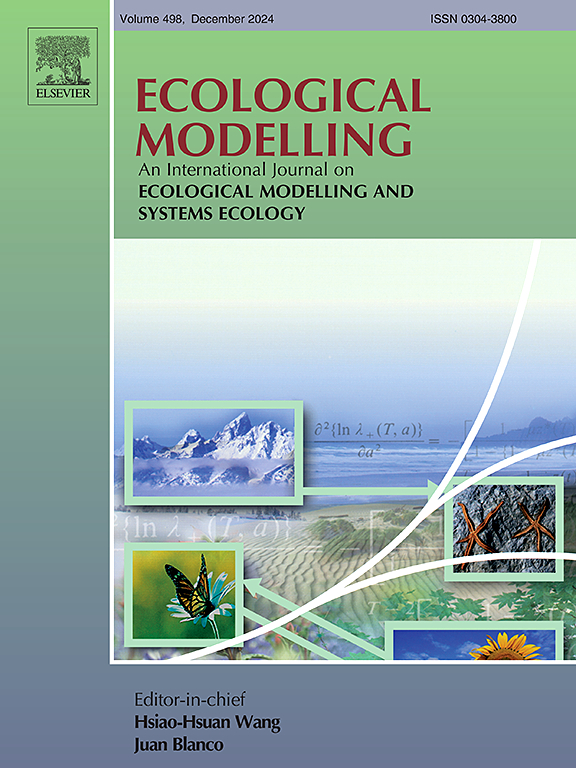Addressing Data Limitations to Explore Management Strategies and Adaptations Using Stylized Agent-Based Modeling: A Case Study of Socio-Environmental Systems
IF 2.6
3区 环境科学与生态学
Q2 ECOLOGY
引用次数: 0
Abstract
This research employs a stylized agent-based model to investigate the complex interactions between human activities and environmental processes, focusing on the Lake Urmia Basin. A key contribution of this study is promoting the application of stylized ABMs to tackle socio-environmental challenges, especially when nonlinearity and multifaceted dynamics make it difficult to compile comprehensive data for developing management strategies. The primary objective of the model is to simplify these intricate dynamics, making it easier to explore key drivers of water resource depletion and system resilience. By abstracting the system, the model allows examination of various scenarios—such as improvements in irrigation efficiency and crop management strategies—without the need for detailed real-world data. Over 100 agricultural years (timesteps), the model simulates agricultural impacts on lake water area, irrigation practices, and farmer decision-making, highlighting critical feedback loops between human behavior and environmental outcomes. The benefits of this stylized modeling approach include its flexibility in testing hypothetical scenarios and its capacity to isolate key variables that influence the dynamics of human-environment systems. This simplicity allows researchers to identify broad patterns of behavior and system responses, making it an effective tool for evaluating water management strategies. The results show that while increasing irrigation efficiency and reducing water-intensive crops can delay system collapse, the most successful scenario requires both interventions at their highest levels. However, a more practical approach involving moderate improvements in both areas could significantly enhance the system's resilience. This research emphasizes the advantages of stylized ABMs in supporting sustainable water management practices.
解决数据限制,探索管理策略和适应使用程式化的基于主体的建模:社会环境系统的案例研究
本研究以乌尔米亚湖流域为研究对象,采用程式化的agent模型来研究人类活动与环境过程之间的复杂相互作用。本研究的一个关键贡献是促进了程式化ABMs的应用,以应对社会环境挑战,特别是当非线性和多方面的动态使得编制综合数据以制定管理策略变得困难时。该模型的主要目标是简化这些复杂的动态,使其更容易探索水资源枯竭和系统恢复力的关键驱动因素。通过对系统进行抽象,该模型可以在不需要详细的真实数据的情况下,对各种场景进行检查,例如灌溉效率的提高和作物管理策略的改进。超过100个农业年(时间步长),该模型模拟了农业对湖泊面积、灌溉实践和农民决策的影响,突出了人类行为和环境结果之间的关键反馈循环。这种程式化建模方法的好处包括在测试假设情景时的灵活性,以及隔离影响人类-环境系统动态的关键变量的能力。这种简单性使研究人员能够确定行为和系统反应的广泛模式,使其成为评估水管理策略的有效工具。结果表明,虽然提高灌溉效率和减少水密集型作物可以延缓系统崩溃,但最成功的情况需要这两种干预措施的最高水平。然而,在这两个方面进行适度改进的更实际的方法可以显著增强系统的弹性。本研究强调了程式化ABMs在支持可持续水资源管理实践方面的优势。
本文章由计算机程序翻译,如有差异,请以英文原文为准。
求助全文
约1分钟内获得全文
求助全文
来源期刊

Ecological Modelling
环境科学-生态学
CiteScore
5.60
自引率
6.50%
发文量
259
审稿时长
69 days
期刊介绍:
The journal is concerned with the use of mathematical models and systems analysis for the description of ecological processes and for the sustainable management of resources. Human activity and well-being are dependent on and integrated with the functioning of ecosystems and the services they provide. We aim to understand these basic ecosystem functions using mathematical and conceptual modelling, systems analysis, thermodynamics, computer simulations, and ecological theory. This leads to a preference for process-based models embedded in theory with explicit causative agents as opposed to strictly statistical or correlative descriptions. These modelling methods can be applied to a wide spectrum of issues ranging from basic ecology to human ecology to socio-ecological systems. The journal welcomes research articles, short communications, review articles, letters to the editor, book reviews, and other communications. The journal also supports the activities of the [International Society of Ecological Modelling (ISEM)](http://www.isemna.org/).
 求助内容:
求助内容: 应助结果提醒方式:
应助结果提醒方式:


